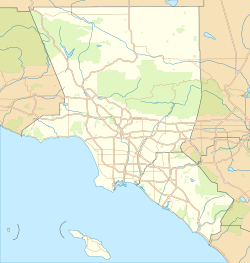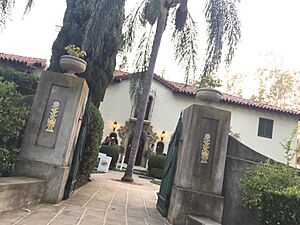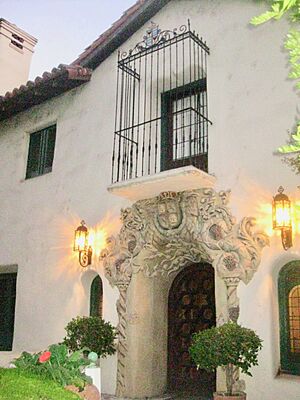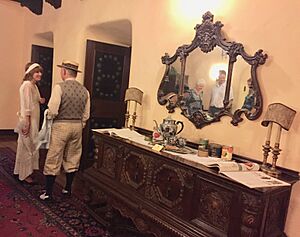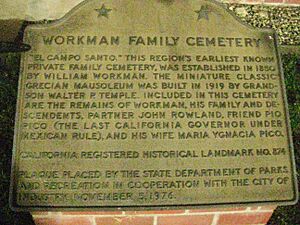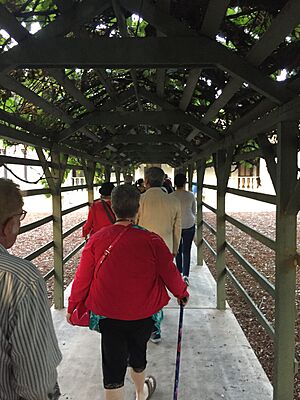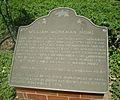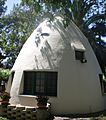Workman and Temple Family Homestead Museum facts for kids
|
Workman Adobe
|
|
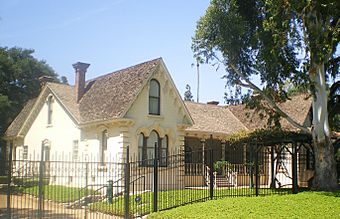 |
|
| Location | 15415 East Don Julian Rd., City of Industry, California |
|---|---|
| Built | 1842, 1870 remodel |
| Architect | Ezra F. Kysor (attributed 1870 remodel) |
| Architectural style | Picturesque Country |
| NRHP reference No. | 74000519 |
Quick facts for kids Significant dates |
|
| Added to NRHP | November 20, 1974 |
The Workman and Temple Family Homestead Museum is a special place in City of Industry, California. It's like a time capsule! This museum shows off the old homes and a private cemetery that belonged to the Workman-Temple family. It's a great spot to learn about California's past.
Contents
The Workman House: A Pioneer's Home
William Workman's Journey
William Workman (1799–1876) was born in England. He moved to the United States when he was young. He traveled west to a place called Taos, where he got married. In 1841, he moved even further west to the San Gabriel Valley. At that time, this area was part of Mexico.
Building the Adobe Home
William Workman bought land in a place called Rancho La Puente. In 1842, he built an adobe house there. Adobe is a building material made from earth and organic materials. Over the years, the house grew bigger. By 1870, it was updated with new brick sections and a second floor. It also got fancy decorations on the outside.
Some people think Ezra F. Kysor designed this update. He was a famous architect in Los Angeles. However, there are no old papers that prove he worked on the Workman house.
A Historic Landmark
The Workman Adobe became a special historic site on November 20, 1974. It was added to the National Register of Historic Places (NRHP). It also became a California State Register of Historic Landmarks, number 874. This happened because of its history and the family cemetery on the property. A special marker was placed there on November 5, 1976. This date marked 135 years since the Workman family arrived.
Inside the Workman House
The house is quite large, about 19 feet deep and 72 feet wide. It has big porches on both the north and south sides. On the first floor, there are eight rooms. The second floor has three finished rooms, with three more likely finished later.
The house changed a lot over time. From 1930 to 1935, it was used as classrooms for a military school. Later, it was a home, then an office and nurse's quarters for a health center. In 1963, the City of Industry bought the house and cemetery.
Many original parts of the house are gone. But some old details still remain. These include a staircase from around 1870. There are also two marble fireplaces from that time. A fancy ceiling decoration from that era also survives. In the late 1970s, the outside of the house was restored. The entire east wall had to be rebuilt because it was adobe and had fallen down.
La Casa Nueva: The Temple Family Home
The Homestead Museum also features "La Casa Nueva," which means "The New House." This house is a beautiful example of Spanish Colonial Revival Style architecture. The Temple family built it between 1922 and 1927.
Designing and Building La Casa Nueva
The Temple family helped design their own home. A well-known Los Angeles architecture company, Walker and Eisen, drew up the plans. Later, in 1924, architect Roy Selden Price was hired to change the design.
The house was mostly built with adobe bricks. These bricks were handmade by skilled workers led by Pablo Urzua from Mexico. The main builder was Sylvester Cook.
Features of the House
La Casa Nueva is huge, about 9,000 square feet! It has twenty-six rooms. These include nine bedrooms and six bathrooms. There's even a barber shop and a large cold storage unit. The basement has an old bank vault for storage.
The house has many unique features. You can see hand-painted designs on the windows. There's also lots of colorful stained glass. One special feature is a picture of a madonna with a child. But the faces look more modern, not traditional.
Later Uses and Restoration
The Temple family only lived in the fully finished house for two years (1928 and 1929). After that, it was rented to Lawrence Lewis. He ran a boys' military academy called Raenford there from 1930 to 1935.
Later, the California Bank owned the house. Caretakers lived there until 1940. Then, Harry and Lois Brown bought it. They moved their health center, El Encanto, to the site.
The house was restored in the years that followed. It opened as part of the Workman and Temple Family Homestead Museum in May 1981. Most of the house was still in good shape. Some parts were rebuilt, and the house was filled with old furniture. Some original family items were given back by the Temple family's descendants.
El Campo Santo Cemetery: A Family Resting Place
The family cemetery, called El Campo Santo, was started in the 1850s. The first known burial was William Workman's older brother, David, in November 1855.
The Chapel and Its History
In 1856, an artist named Henry Miller visited the Workman House. He drew plans for a chapel that William Workman wanted to build. On May 30, 1857, the first stone for St. Nicholas's Chapel was laid. It was named after Workman's wife, Nicolasa Urioste de Valencia.
The chapel was built in a Gothic Revival style. It was finished by the early 1860s. It had fancy gilt ceilings and stained glass windows. The cemetery was only used for Workman and Temple family members and friends. Church services were held there regularly.
Restoration of the Cemetery
After the family lost their land in 1900, the chapel was said to have burned down. Many gravestones were removed, and the site was damaged. William Workman's grandson, Walter Temple, sued in 1907 to stop the destruction.
The cemetery was neglected for ten years. Then, Walter Temple became rich from oil on his ranch. He bought back the ranch and cemetery. From 1919 to 1921, Walter's main goal was to fix up El Campo Santo. He also built a mausoleum where the chapel used to be.
The cemetery reopened in April 1921. The remains of Pío Pico, the last governor of California, and his wife were moved into the mausoleum. It also holds the remains of other important pioneer families. The Workman Home and Family Cemetery are now California Historical Landmark No. 874.
The cemetery continued to be used by the Temple family and later by the Brown family. In recent years, three more burials have taken place. Walter P. Temple was moved to the site in 2002. His son, Walter Jr., and daughter-in-law, Nellie Didier, were buried there in 1998. A spot is saved for their daughter. After that, the cemetery will no longer be used for new burials.
Visiting the Homestead Museum
The museum opened on May 1, 1981. The City of Industry owns and pays for it. Guided tours of the Workman Home, 'La Casa Nueva' , and El Campo Santo Cemetery are available. You can take a tour every hour from 1 to 4 p.m., Wednesday through Sunday. The museum is closed on major holidays.
The museum also has many fun events throughout the year. These include festivals, living history tours on weekends, and workshops. It's a great place to explore history!
California Historic Landmark Marker
A special marker at the site tells part of its history:
- NO. 874 WORKMAN HOME AND FAMILY CEMETERY - William Workman and John Rowland led the first group of settlers from the eastern United States. They arrived in Southern California on November 5, 1841. They owned and developed the huge 48,790-acre La Puente Rancho together. Workman started this adobe home in 1842. He updated it in 1872 to look like a large house from his home country, England. He also created 'El Campo Santo,' which is the earliest known private family cemetery in this area, in 1850. The small, classic Greek-style mausoleum was built in 1919 by his grandson, Walter P. Temple.
Images for kids


